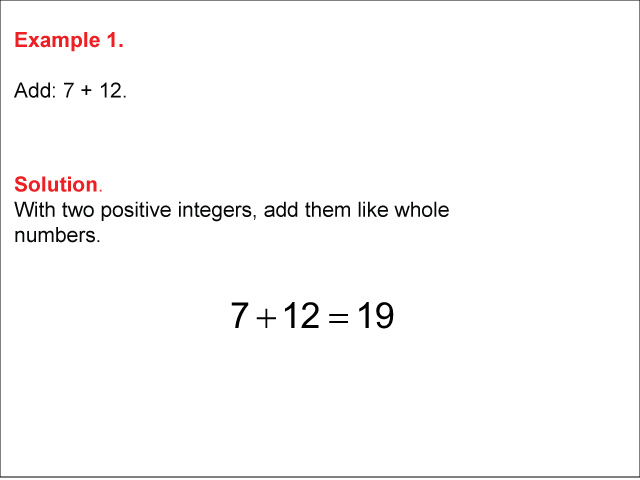
Display Title
Math Example--Arithmetic--Adding Two Integers: Example 1
Display Title
Math Example--Arithmetic--Adding Two Integers: Example 1

Topic
Integers
Description
This example demonstrates the addition of two positive integers: 7 + 12. The solution is straightforward, as it involves adding two whole numbers. When dealing with positive integers, the addition process is similar to that of whole numbers. In this case, 7 + 12 equals 19.
Understanding integer operations is a fundamental concept in mathematics. Integers include both positive and negative whole numbers, as well as zero. This collection of examples covers various scenarios of adding integers, including positive-positive, positive-negative, and negative-negative combinations. By presenting these different cases, students can grasp the rules and patterns governing integer addition.
The importance of multiple worked-out examples cannot be overstated in mathematics education. Each example in this collection provides students with an opportunity to see the problem-solving process in action. By examining various scenarios, students can identify patterns, reinforce their understanding, and develop confidence in their ability to perform integer operations. This repetition and exposure to different problem types help solidify the concept in students' minds, making it easier for them to apply these skills to new situations.
For a complete collection of math examples related to Adding and Subtracting Integers click on this link: Math Examples: Adding and Subtracting Integers Collection.
| Common Core Standards | CCSS.MATH.CONTENT.6.NS.C.5 |
|---|---|
| Grade Range | 6 - 12 |
| Curriculum Nodes |
Algebra • The Language of Math • Numerical Expressions |
| Copyright Year | 2014 |
| Keywords | integers, integer, positive numbers, negative numbers, positive, negative, zero, adding integers, subtracting integers, adding and subtracting integers |